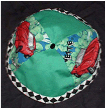
Go fix yourself a nice glass of tea, then come back and fasten your carpal tunnel wrist brace. This tour is going to take you through quilted Judaica made quilters from around the world! (You can click on most of these images for a MUCH better view).
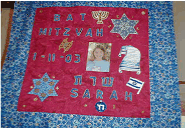
Two years later, Shirley sent me the image of a sophisticated embellished memory quilt. In a way, it developed from the bat mitzvah.
"A few months before the event, my aunt gave me a 1912 photo of my maternal great-grandparents in Botosani, Romania. That photograph became the subject of my bat mitzvah speech. Even afterwards I was haunted by the photograph, thinking about what lay behind their stern expressions.
"I saw a postcard listed on the Internet that showed Janow Trembowla, the shtetl in Galicia that my mother-in-law came from, and where she was hidden during the Holocaust. Now I had two photographs. Then I recalled that many years before, I had found a photograph of the wooden synagogue in Janow Trembowla. Finally, on the Internet I found a photograph of Trembowla, the nearby larger town.
" I used June Tailor's fabric inkjet transfer sheets to scan and print the photographs. I took them all, some fabric and embellishments - including skeleton leaves found at a Michael's (craft store) - to Natasha Kempers-Cullen's class in embellished art quilts at Quilting by the Lake in New York. Without much of a plan, I sewed together four panels of fabric, and stamped hamsa's randomly on them in gold textile paint. Using Natasha's technique, I laid the photographs, gold and blue threads, some star of David glitter and sequins and the skeleton leaves under a layer of tulle. After carefully pinning the tulle, batting and a backing together, I machine quilted it with metallic thread, in a grid pattern. I bordered the quilt with gold brocade ribbon with a vaguely European pattern. I framed the whole thing in a gold frame.
"It now is hanging on my dining room wall. It measures 14 1/2" x 19". I think of the skeleton leaves and gold threads as tying together the Judaic ancestry of our family, combining my own and my husband's genealogy, leading up to the photograph of our children." Shirley is at Shirleynj (at) aol.com
"A few months before the event, my aunt gave me a 1912 photo of my maternal great-grandparents in Botosani, Romania. That photograph became the subject of my bat mitzvah speech. Even afterwards I was haunted by the photograph, thinking about what lay behind their stern expressions.
"I saw a postcard listed on the Internet that showed Janow Trembowla, the shtetl in Galicia that my mother-in-law came from, and where she was hidden during the Holocaust. Now I had two photographs. Then I recalled that many years before, I had found a photograph of the wooden synagogue in Janow Trembowla. Finally, on the Internet I found a photograph of Trembowla, the nearby larger town.
" I used June Tailor's fabric inkjet transfer sheets to scan and print the photographs. I took them all, some fabric and embellishments - including skeleton leaves found at a Michael's (craft store) - to Natasha Kempers-Cullen's class in embellished art quilts at Quilting by the Lake in New York. Without much of a plan, I sewed together four panels of fabric, and stamped hamsa's randomly on them in gold textile paint. Using Natasha's technique, I laid the photographs, gold and blue threads, some star of David glitter and sequins and the skeleton leaves under a layer of tulle. After carefully pinning the tulle, batting and a backing together, I machine quilted it with metallic thread, in a grid pattern. I bordered the quilt with gold brocade ribbon with a vaguely European pattern. I framed the whole thing in a gold frame.
"It now is hanging on my dining room wall. It measures 14 1/2" x 19". I think of the skeleton leaves and gold threads as tying together the Judaic ancestry of our family, combining my own and my husband's genealogy, leading up to the photograph of our children." Shirley is at Shirleynj (at) aol.com
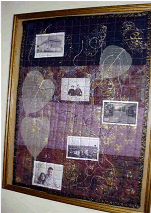

SHIRLEY WEITZ First, we have a wallhanging/keepsake that Shirley made in 2002 for her daughter Sarah's Bat Mitzvah, using a wide variety of tchatchkes, including stencils, sequinned appliques, charms buttons and Judaic prints. (It's about 38" square).

RUTH HARRIS This is the ultimate personalized double wedding ring quilted huppah! This Oklahoma artist had never seen a huppah before her niece asked her to make one. She collected hand-tracings from brides' and grooms' families, transferred them onto Wonder Under and then cut the shapes from fancy fabrics. Next, she arranged the hands in a double wedding ring pattern---bride's family on one side, groom's on the other, couple's fingers intertwined! Names (and even wedding rings) are embroidered on the hands. She reports that the children attending the wedding were particularly fascinated by this huppah --- they placed their hands up against it and found they had grown in the three months since she'd collected the tracings!
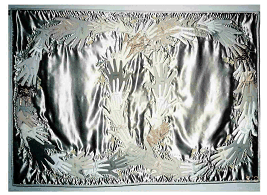
Finished size, 63" x 44".
(c) 2003, Ruth Harris
(c) 2003, Ruth Harris

ESTHER WEISS This joyous and complex-looking huppah was made entirely from l/8 yard piecesof striped fabric, from a series. Strips of the multicolored fabrics were sewn together, then simply cut into half-square triangles. See all those amazing Jewish stars? The Washington D.C- area maker, Esther Weiss, reports, "The stars were by accident. I was working to balance the colors out in some orderly fashion and it must have been subconscious. I'm not usually lucky, although perhaps this quilt is. The owners just had their first child. He's great!" It's hard to see in this photo, but there's a lovely Tree of Life quilted in the center, in metallic threads. Esther's email address is esthermcw (at) hotmail.com.
Finished size 66" x 66"
(c) 1997, Esther Weiss.
Finished size 66" x 66"
(c) 1997, Esther Weiss.
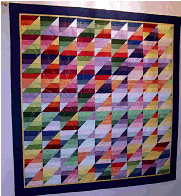

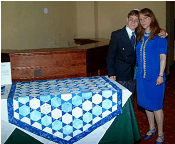
JERI RIGGS This well-known art quilter started this precision-pieced signature quilt TWO WEEKS before her son's bar mitzvah! (Don't try this at home). It was pieced from light-colored hexagons, with two dark equilateral triangles attached to each, then sewn together in rows: "There are no set-in seams," she says, like that makes it a lot easier (it doesn't).
The quilt was still just a top during the bar mitzvah. She ironed freezer paper to the backs of the light-colored pieces, to stabilize them during signing. (She had some practice fabric available at the party, which she also turned into an art quilt!).
And by the way, she trimmed the dress, dyed the shoes, beaded the necklace, AND made a Torah cover for the event. And look what a nice son she raised! Jeri is a serious overachiever, as you will see from her breathtaking art quilts at http://www.jeririggs.com .
The quilt was still just a top during the bar mitzvah. She ironed freezer paper to the backs of the light-colored pieces, to stabilize them during signing. (She had some practice fabric available at the party, which she also turned into an art quilt!).
And by the way, she trimmed the dress, dyed the shoes, beaded the necklace, AND made a Torah cover for the event. And look what a nice son she raised! Jeri is a serious overachiever, as you will see from her breathtaking art quilts at http://www.jeririggs.com .
RUTH ROSENBERG. This Northern California quilter explains that the first piece, an intricate interlaced stars pattern was inspired by a Marilyn Felber class. She hopes to hang it in her synagogue's small chapel. The size is 45" x 45".
If the second piece, a cool geometric matzoh cover looks vaguely famliar, there's a reason - the pattern is from Mae Tupa Rockland's book, 'The New Work of Our Hands.' "It's ALL Y-seams," Ruth reports casually. She not only pulled off those fussy seams, but also refreshed the color pallette, and embellished with the Hebrew word for 'matzoh', using a Pfaff digital disc. Ruth's email address is rsr061 (at) yahoo.com.
If the second piece, a cool geometric matzoh cover looks vaguely famliar, there's a reason - the pattern is from Mae Tupa Rockland's book, 'The New Work of Our Hands.' "It's ALL Y-seams," Ruth reports casually. She not only pulled off those fussy seams, but also refreshed the color pallette, and embellished with the Hebrew word for 'matzoh', using a Pfaff digital disc. Ruth's email address is rsr061 (at) yahoo.com.

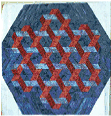
DEBBIE MARKOWITZ This Jerusalem-based quilter has made a wide variety of quilts, with both Jewish and non-denominational. Her 'Chanukah Menorah' quilt, with a gently gradated background, is one of my favorites. And she has made one of the most astonishing photo-memory quilts I have ever seen-- with 99 photos set into the top of a fantastic arrangement of baby blocks. See all her work at http://www.geocities.com/studiodebbie/quilts.html
RICKI MOFFAT Her work simply knocked my socks off. Check out especially the Tallis and the Elijah-late-on-Passover-night-after-drinking-from-all-those-cups portrait. Click on 'Quilts' after you get to this address: http://photos.yahoo.com/bc/ricki_moffat/ (when you're done looking at them, click on 'Socks' for her knitted art!) Her email address is ricki_moffat (at) yahoo.ca.




DOTTIE KAPLAN There's a lot to be said for an unbacked huppa (instead of a fully quilted quilt) - the former is much lighter and easier to suspend. Dottie, who is from Allentown, Pennsylvania sent me these marvelous pictures of a huppa made for her daughter, Debra Kaplan Kira in Florida. A friend of the bride sent hexagons to all the guests to decorate. When they were returned, she simply glued them to the blue cloth. The poles, made by the father of the bride, were actually stair rods, wound with artificial flowers and vines. The huppa was displayed vertically during the reception. The couple plan to keep it as a decorative wall hanging, rather than a quilt. Dottie's email address is Dottie (at) kaplans.com.
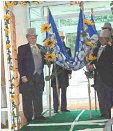
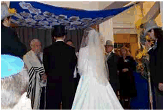

SUZANNE NEUSNER You may have seen this well-known New Jersey quilter's huppot and matzoh covers on Simply Quilts. Two of her huppot appeared my Quilters' Newsletter Magazine article, July/August 03. She now has a website! It's at http://www.huppah.com. Click on 'Samples' to see her work.

JO-ANN MULLEN, from Estes Park, Co., sent me these treats. The first is a blue-and-white baby quilt which makes excellent use of several Judaic print fabrics.
Jo-Ann also told me about this 'Rosh Hodesh' quilt, made by the seven members of Jo-Ann's group which meets every month. Each woman made a block---the ones who aren't into visual arts WROTE on their blocks (for example, one free-associated positive words). This quilt travels to a different members' home each month, and it also accompanies any member who is going through tough times. It's even been to a hysterectomy. "It will continue to be used whenever one of us needs to have the rest of the group with them for support and caring," Jo-Ann writes. You can reach Jo-Ann at a Jmullen2 (at) aol.com.
Jo-Ann also told me about this 'Rosh Hodesh' quilt, made by the seven members of Jo-Ann's group which meets every month. Each woman made a block---the ones who aren't into visual arts WROTE on their blocks (for example, one free-associated positive words). This quilt travels to a different members' home each month, and it also accompanies any member who is going through tough times. It's even been to a hysterectomy. "It will continue to be used whenever one of us needs to have the rest of the group with them for support and caring," Jo-Ann writes. You can reach Jo-Ann at a Jmullen2 (at) aol.com.
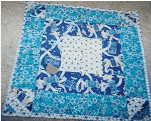
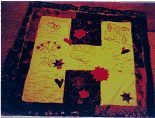

BEATRIZ ACKERMAN This New Yorker created this gorgeous, spiritually-charged challah cover. And with the modern fabrics and quilting techniques, she integrated traditional approaches, with the elegant, cross-stitched motif in the center. Bea writes, "The name of the piece, 'Vayehi erev vayei boker,' is from Genesis 1:5-31 'And it was evening, and it was morning.' Each day of Creation ends in this verse, until the sixth day, when G-d 'completed His work, and withdrew from His activity. Every Shabbat we commemorate the Creation by resting as He did."
There's also an agricultural theme, Bea notes. "It represents the elements' of G-d's Creation that, in turn, give us the means to produce our own sustenance. We gratefully bless Him for being the one 'who extracts bread from the land.' These words, from the blessing over the challah, are embroidered on the center of the quilt in Hebrew, "hamotzi lechem min ha'aretz.'"
There's also an agricultural theme, Bea notes. "It represents the elements' of G-d's Creation that, in turn, give us the means to produce our own sustenance. We gratefully bless Him for being the one 'who extracts bread from the land.' These words, from the blessing over the challah, are embroidered on the center of the quilt in Hebrew, "hamotzi lechem min ha'aretz.'"
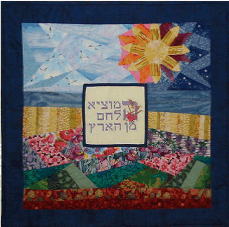
Bea started with a mockup, using fabric snippets. Once she liked the arrangement, she glued them to paper, enlarged them on a color copier, kept one copy as a reference and cut up another to create templates. She pieced the top by machine. All the quilting was done by hand.
As for the cross stitch - she designed the lettering, pomegranate and wheat clusters on graph paper. Stitching was done with three strands of embroidery thread on Aida cloth. She trimmed the cloth to size, and, with a toothpick, added a bead of fabric glue across the edges to seal. She then appliquéd the rectangle to the center of the cover, and framed it with quarter-inch bias tape appliquéd over the border
By the way, Bea has a challenging day-job finance. And if you're suspecting that she's another one of these overachievers, you're right - she recently cross stitched 400 napkin rings and made 4000 petit fours for her son's bar mitzvah. "Besides quilting I also do Hebrew calligraphy and have made several Ketubot, so the Hebrew letters are not a big deal for me to design. Even though I'm 'stuck' in the business world now, I was once a Hebrew and Torah teacher so I guess I have plenty to draw Judaic inspiration from." Thank you Bea, for sharing your inspiration here. You can contact Bea at backerman (at) CANTORSeinuk.com .
As for the cross stitch - she designed the lettering, pomegranate and wheat clusters on graph paper. Stitching was done with three strands of embroidery thread on Aida cloth. She trimmed the cloth to size, and, with a toothpick, added a bead of fabric glue across the edges to seal. She then appliquéd the rectangle to the center of the cover, and framed it with quarter-inch bias tape appliquéd over the border
By the way, Bea has a challenging day-job finance. And if you're suspecting that she's another one of these overachievers, you're right - she recently cross stitched 400 napkin rings and made 4000 petit fours for her son's bar mitzvah. "Besides quilting I also do Hebrew calligraphy and have made several Ketubot, so the Hebrew letters are not a big deal for me to design. Even though I'm 'stuck' in the business world now, I was once a Hebrew and Torah teacher so I guess I have plenty to draw Judaic inspiration from." Thank you Bea, for sharing your inspiration here. You can contact Bea at backerman (at) CANTORSeinuk.com .

MARILYN LEVY Kippot...Matzoh covers....Tallitot and Tallit bags....this quilt artist from Hamilton, Ontario, Canada does it all, magnificently.Her specialty: 'Watercolor' quilting techniques. At right is one of her challah covers (machine-quilted, and hand embroidered). She also uses the technique beautifully on tallitot. Be sure to see the challah cover that matches the brides' Villeroy and Boch dishes....and the pomegranate challah cover with 613 french knots representing 613 mitzvot! Her web page is http://www.levyjudaica.homestead.com.


BERTA GOLDGABER The work of this Missouri quilt artist is glorious, both in color and design. I am in love with the 'Two Tablets' wall-hanging. Berta recently introduced a line of greeting cards with her quilts. See more of her work at http://www.jewishart.org/fabric_art/quilt.html.
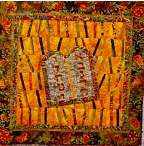

ELANA SCHACHTER This quilt, 'Counting the Omer,' by the Israeli artist, is based on the Kabbalistic tree of life. The tree, as the Kabbalists see it, is a theoretical map of reality, comprised of ten sephirot, or divine modes.
"In the Jewish tradition, we count the 49 days between Passover and Shavuout," Schachter explains. "Each day has a special spiritual quality. The process of consciously counting the days is a way of fixing that quality in ourselves and the world." In the quilt, each of the lower seven septagons represents both a sephira and a week, and each point of the star represents a day. The colors correspond to the spectrum, and Elana used fabrics with images that correspond to the things named in Genesis that were created on that day of the week. The background and upper three septagons are made from a satiny fabric, and the others are cotton. A semitransparent ribbon marks the paths between the sephirot. All machine quilted, 60" x 37" . This quilt is also a working calender. The picture doesn't show that there's a clock hand which can be moved from sephira to sephira, and rotated from point to point to keep track of the day!
Elana is fearless with satins. Below is one of Elana's chuppot, made for her daughter and son-in-law's wedding. . Here it was hung for a one-night art exhibit ---for the actual event, Elana sewed rings to the corners, that held it on poles. "When it is held on poles, it can be held more tautly, and the drops hang straighter. We considered having people hold it for the art show, but couldn't find any volunteers. Can't imagine why!" (LOL!)
The chuppah is made in five parts - the center, plus four "drops" are attached with velcro. "The drops have the priestly blessing on them," Elana explains. " The center is the cruvim - the 'cherubs' who decorated the aron kodesh in the mishkan. The story is that the voice of God emanated from between the cherubs. I wrote on the label a blessing that the couple should remember that the voice of God is between them."
"The chuppah has been used several times since then, and I have copied the invitations of all the weddings onto fabric and added them to the back. The whole thing was made in a month because the date of the wedding got moved forward, so there is only minimal quilting around the shapes." Elana, who lives in Tzfat, does commissioned work. Contact her at elana613 (at) gmail.com.
"In the Jewish tradition, we count the 49 days between Passover and Shavuout," Schachter explains. "Each day has a special spiritual quality. The process of consciously counting the days is a way of fixing that quality in ourselves and the world." In the quilt, each of the lower seven septagons represents both a sephira and a week, and each point of the star represents a day. The colors correspond to the spectrum, and Elana used fabrics with images that correspond to the things named in Genesis that were created on that day of the week. The background and upper three septagons are made from a satiny fabric, and the others are cotton. A semitransparent ribbon marks the paths between the sephirot. All machine quilted, 60" x 37" . This quilt is also a working calender. The picture doesn't show that there's a clock hand which can be moved from sephira to sephira, and rotated from point to point to keep track of the day!
Elana is fearless with satins. Below is one of Elana's chuppot, made for her daughter and son-in-law's wedding. . Here it was hung for a one-night art exhibit ---for the actual event, Elana sewed rings to the corners, that held it on poles. "When it is held on poles, it can be held more tautly, and the drops hang straighter. We considered having people hold it for the art show, but couldn't find any volunteers. Can't imagine why!" (LOL!)
The chuppah is made in five parts - the center, plus four "drops" are attached with velcro. "The drops have the priestly blessing on them," Elana explains. " The center is the cruvim - the 'cherubs' who decorated the aron kodesh in the mishkan. The story is that the voice of God emanated from between the cherubs. I wrote on the label a blessing that the couple should remember that the voice of God is between them."
"The chuppah has been used several times since then, and I have copied the invitations of all the weddings onto fabric and added them to the back. The whole thing was made in a month because the date of the wedding got moved forward, so there is only minimal quilting around the shapes." Elana, who lives in Tzfat, does commissioned work. Contact her at elana613 (at) gmail.com.
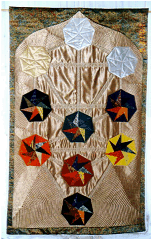
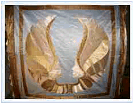


JILL PACE made this exuberant wall-hanging for her daughter's bat mitzvah, which fell during the same week as Sukkot. Thus the etrog and lulav, traditional ritual items for the 'Festival of Booths.' Her daughter's name, in Hebrew, is appliquéd in the lower right hand corner. More of Jill'swork is at http://home.covad.net/~ateich/. (Check out A Passion for Chocolate! which is another kind of religious experience!)
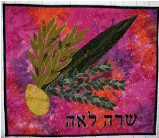

JEAN BROMER This picture was sent to me by that lovely bride, Meg van Achterberg. Meg and her groom are standing under a huppah made by Meg's grandmother, Jean, of Easton, Connecticut.
Meg wrote, "My husband, Ariel, and I were married 4 years ago. He is Jewish; I am not. When my grandmother, a then-80 year-old avid quilter, learned about the huppah tradition, she decided that there was nothing to do but quilt one for our ceremony. Her good friend Cynthia explained the structure of the huppah and suggested that she use the Biblical phrase, 'I am my beloved and my beloved is mine.' My husband's father, a scholar of Near-Eastern languages, provided the Hebrew translation, which my computer-savvy uncle helped her make into a stencil. She made the most exquisite white quilted huppah, which you see in the attached photos. On the top was a blue star of David. On two of the hanging sides grandma embroidered the English 'beloved' phrase in gold thread, on the other two sides she embroidered the Hebrew. Then she attached beautiful gold fringe to the entire thing. My parents made the poles out of PVC piping and white ribbon, an we were ready to go. Between the embroidery and the fringe I think it was more work than any quilt she had ever made, but I think the results are spectacular. And so did everyone who was there! It was a remarkable gift from a remarkable grandma! It will be a heirloom to pass through the generations, and has since been used in the wedding of one of my bridesmaids, Jill." Meg is at drmargriet (at) msn.com .
Meg wrote, "My husband, Ariel, and I were married 4 years ago. He is Jewish; I am not. When my grandmother, a then-80 year-old avid quilter, learned about the huppah tradition, she decided that there was nothing to do but quilt one for our ceremony. Her good friend Cynthia explained the structure of the huppah and suggested that she use the Biblical phrase, 'I am my beloved and my beloved is mine.' My husband's father, a scholar of Near-Eastern languages, provided the Hebrew translation, which my computer-savvy uncle helped her make into a stencil. She made the most exquisite white quilted huppah, which you see in the attached photos. On the top was a blue star of David. On two of the hanging sides grandma embroidered the English 'beloved' phrase in gold thread, on the other two sides she embroidered the Hebrew. Then she attached beautiful gold fringe to the entire thing. My parents made the poles out of PVC piping and white ribbon, an we were ready to go. Between the embroidery and the fringe I think it was more work than any quilt she had ever made, but I think the results are spectacular. And so did everyone who was there! It was a remarkable gift from a remarkable grandma! It will be a heirloom to pass through the generations, and has since been used in the wedding of one of my bridesmaids, Jill." Meg is at drmargriet (at) msn.com .


DIANA FORMAN made this intricate and spectacular pieced star quilt for her daughter's bat mitzvah. The quilt features 12 six-pointed stars on the front, representing her daughter's first 12 years. The quilt is based on a pattern in Judy Martin's 'The Creative Pattern Book,' p. 104. On the back is one more six-pointed star, for the 13th year, with photo-transferred pictures, notes and drawings from family members. Diana is at dforman (at) comcast.net.
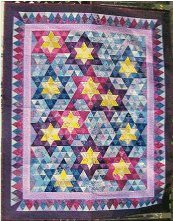

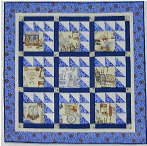
ELIZABETH JANOWITZ of Pinecrest, Florida, sent me many wonderful images of her Judaica. The first is "Holidays with Color," about 45" square. This features a Judaic-themed fabric scattered with old-fashioned etchings of the major holidays---all different shapes and sizes! Very tough to cut and unify, but Elizabeth did it gracefully, with these intricately pieced bear's paws blocks. Those varied blues, alternating with white, create a wonderful vibration.
The piece is called 'Peaceful Shabbat', and it's 44" x 50" The central star is from a pattern by Sara Nephew, and Elizabeth designed the appliques.
Next, her sublime "Star of David", about 32" wide, is based on a paper-foundation pieced design published in Quilters Newsletter Magazine a couple of years ago (the pattern can be found on their website by entering "Rachel's Star" in the search box at www.quiltersnewsletter.com/qnm/feature20.htm. )
Reach Elizabeth at ejanowitz (at) bellsouth.net.
The piece is called 'Peaceful Shabbat', and it's 44" x 50" The central star is from a pattern by Sara Nephew, and Elizabeth designed the appliques.
Next, her sublime "Star of David", about 32" wide, is based on a paper-foundation pieced design published in Quilters Newsletter Magazine a couple of years ago (the pattern can be found on their website by entering "Rachel's Star" in the search box at www.quiltersnewsletter.com/qnm/feature20.htm. )
Reach Elizabeth at ejanowitz (at) bellsouth.net.
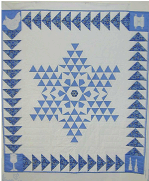
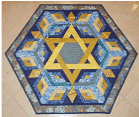

SUSAN SLESINGER My friend Susan is brilliant and funny, so are her quilts, and her hand-quilting is, by the way, exquisite! The first piece is an original wall-hanging which reveals the truth about Sunbonnet Sue and Overall Bill: Not their real names! Who knew? It's called 'Sam and Sadie's Holidays,' (36"x 32"), and along with displaying some of their favorite Jewish carbs, there's a latke recipe quilted into the border!
Another extraordinary piece is this Chanukah wall hanging. Susan made it more than a decade ago, which accounts for the vintage fabrics. Look how she created the flames from leaves! (Those flames are STUFFED!) This quilt was based on a design by Piecemakers' Crystal Carter.
Another extraordinary piece is this Chanukah wall hanging. Susan made it more than a decade ago, which accounts for the vintage fabrics. Look how she created the flames from leaves! (Those flames are STUFFED!) This quilt was based on a design by Piecemakers' Crystal Carter.

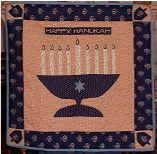

GISHA WOGIER, of Kfar Yona, Israel, made this magnificent log-cabin block chuppah for her daughter's wedding in September '04.
The chuppah's colors reflect those of Israel's flag. "The flag includes two blue stripes on a white background, with a Star of David in the center," Gisha writes. "The Star of David in my quilt is embroidered with metallic gold, to resemble the yellow star the Jewish people were forced to wear during the Holocaust."
In the centers of the log-cabin blocks, Gisha incorporated many meaningful fabrics, including fabrics from dresses she'd made for her daughters; dresses that her mother and mother-in-law wore to her wedding; and fabrics her quilt group friends gave her. "I also used the initials embroidered on my late father-in-laws tallit bag, in the center of the Magen David."
She embroidered pomegranates - an ancient Jewish symbol of Torah and fertility - on the borders of the canopy.
The piece is 216 cm x 216 cm, and machine pieced, machine and hand embroidered, and quilted with metallic thread. The poles are a natural pine, no varnish, in keeping with the ancient tradition of using tree limbs. She attached four wooden curtain rings to the corners. On the poles, she screwed rounded hooks, from which the rings were hung.
Gisha tells me that this chuppah has also been used at another family member's wedding. On the back, she's planning to add a patch on which she'll write the names of every couple married under it. This quilt is based on another quilt that she made called "Hatikva" which was selected as a finalist in the 'Spirit and Strength' Husqvarna Viking Challenge.) Contact Gisha at rush-s (at) inter.net.il
The chuppah's colors reflect those of Israel's flag. "The flag includes two blue stripes on a white background, with a Star of David in the center," Gisha writes. "The Star of David in my quilt is embroidered with metallic gold, to resemble the yellow star the Jewish people were forced to wear during the Holocaust."
In the centers of the log-cabin blocks, Gisha incorporated many meaningful fabrics, including fabrics from dresses she'd made for her daughters; dresses that her mother and mother-in-law wore to her wedding; and fabrics her quilt group friends gave her. "I also used the initials embroidered on my late father-in-laws tallit bag, in the center of the Magen David."
She embroidered pomegranates - an ancient Jewish symbol of Torah and fertility - on the borders of the canopy.
The piece is 216 cm x 216 cm, and machine pieced, machine and hand embroidered, and quilted with metallic thread. The poles are a natural pine, no varnish, in keeping with the ancient tradition of using tree limbs. She attached four wooden curtain rings to the corners. On the poles, she screwed rounded hooks, from which the rings were hung.
Gisha tells me that this chuppah has also been used at another family member's wedding. On the back, she's planning to add a patch on which she'll write the names of every couple married under it. This quilt is based on another quilt that she made called "Hatikva" which was selected as a finalist in the 'Spirit and Strength' Husqvarna Viking Challenge.) Contact Gisha at rush-s (at) inter.net.il
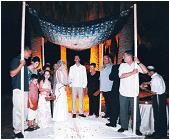

JOYCE BRYAN Need Jewish décor that is spiritual, practical and portable? Joyce Bryan of Long Beach, California rose to the challenge. Joyce belongs to Adat Chaverim of Los Alamitos, CA, a congregation she describes as "small, and somewhat impoverished." And they meet in a church. Thus, they face a problem that many such congregations do--- knockdown decor.
The rabbi, Emily Feigenson, saw Joyce's quilts, asked her to make a large panel for the front of the room. "She wanted something folks could look at during prayers. She said she didn't care what the image was, only that it had to have an 'Eastern theme.'" Joyce recalls. Joyce decided on the skyline of Jerusalem.
But she didn't proceed alone. "After many years working in the nonprofit sector, I was very aware of the need to involve others in this type of project . I asked congregants to contribute pieces of fabric for the project."
So the mortar between the bricks, and parts of buildings, include many donated remnants---a baby's first blanket, a child's toy, a huppa, a grandmothers' handkerchief, a wedding dress, a homemade bathrobe, even frayed napkins, complete with gravy and wine stains. One family donated a piece of brilliant gold and black fabric that had been hung over their daughter's crib for sensory stimulation.
"All of their contributions were used," Joyce says. "Now when folks pray, many of them have before them a piece of their own lives, and they are very emotionally attached to the quilt. It feels terrific."
The result, titled "Jersualem of Gold" (which is also the meaning of the Hebrew inscription) measures 62" x 96". Joyce used satin stitch appliqué, and stuffed work ("I didn't call it trapunto at that time since I didn't know that word!" ). A special frame was constructed for it, and it religiously attends services, bar and bat mitzvahs, weddings, and other special occasions.
The second is Joyce's "Symbols of Jewish Joy", which is also decor for the shul. It's 36" x 80", long and narrow for a quilt, because it was designed to temporarily cover long iconic church plaques. (Before this quilt, the congregants used bed sheets!). The borders are gold lame. It is suspended with a simple garden rod that rests on adjacent window frames. Contact Joyce at joycegero (at)aol.com.
The rabbi, Emily Feigenson, saw Joyce's quilts, asked her to make a large panel for the front of the room. "She wanted something folks could look at during prayers. She said she didn't care what the image was, only that it had to have an 'Eastern theme.'" Joyce recalls. Joyce decided on the skyline of Jerusalem.
But she didn't proceed alone. "After many years working in the nonprofit sector, I was very aware of the need to involve others in this type of project . I asked congregants to contribute pieces of fabric for the project."
So the mortar between the bricks, and parts of buildings, include many donated remnants---a baby's first blanket, a child's toy, a huppa, a grandmothers' handkerchief, a wedding dress, a homemade bathrobe, even frayed napkins, complete with gravy and wine stains. One family donated a piece of brilliant gold and black fabric that had been hung over their daughter's crib for sensory stimulation.
"All of their contributions were used," Joyce says. "Now when folks pray, many of them have before them a piece of their own lives, and they are very emotionally attached to the quilt. It feels terrific."
The result, titled "Jersualem of Gold" (which is also the meaning of the Hebrew inscription) measures 62" x 96". Joyce used satin stitch appliqué, and stuffed work ("I didn't call it trapunto at that time since I didn't know that word!" ). A special frame was constructed for it, and it religiously attends services, bar and bat mitzvahs, weddings, and other special occasions.
The second is Joyce's "Symbols of Jewish Joy", which is also decor for the shul. It's 36" x 80", long and narrow for a quilt, because it was designed to temporarily cover long iconic church plaques. (Before this quilt, the congregants used bed sheets!). The borders are gold lame. It is suspended with a simple garden rod that rests on adjacent window frames. Contact Joyce at joycegero (at)aol.com.
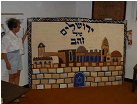
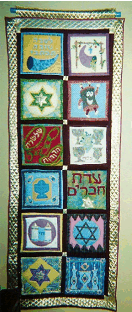

SHULAMIT RON is past chair of Israel's Quilting Association. The quilt at right was commissioned for a wedding in the U.S., and is pieced, appliqued, and embellished with her line of rubber stamps. Shulamit lives in Kadima, Israel, and can be reached at shulamit (at)CanaanArt.com


JOAN GARLAND from Lawrenceville, Georgia, is one of my favorite people! On the left is her first original quilted creation: A scrappy challah cover, 21" x 21". The dark background fabric had a subtle dragonfly print, which she traced with gold metallic thread for the quilted central motifs. The quilted vines in the outer area were a design built into her Husqvarna sewing machine. Joan used commercial quilting fabrics, but I can also imagine this done with family neckties, or other heirloom clothing. Joan gives away a lot of her Judaica to friends, but as for this one, she says --- "I actually like how it came out and I'm going to use it myself!" Joan can be reached at Jagarland (at) bellsouth.net
Update: The second picture is her latest challah cover! Very brave! (Lame is tricky!)
Update: The second picture is her latest challah cover! Very brave! (Lame is tricky!)
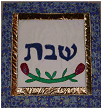
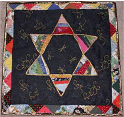



ANN BAUM The huppa was made by Ann for her daughter Carolyn's wedding. "Carolyn sent out twenty 16" squares of fine cotton, and got these sixteen back," Ann explains. " It worked out great, since twenty would have made it entirely too big! The blocks included everything from poetry, to scanned photographs, to paintings, to children's art --- all from very special people in her and her husband's life. It was very meaningful for them. I just banded it together with a hand-painted cotton fabric that Carolyn chose. Carolyn installed grommets, as I wouldn't have dared!" And speaking of hardware, the caterer brought the chuppah from the synagogue to the reception, where he hung it vertically from a rack using---oy!---duct tape!? "I couldn't believe it myself!" says Ann. Her email address is sierrarob (at) aol.com

My buddy Linda Horowitz, of Arcadia, California, thought my kippot were funny - but apparently, not funny enough. So, while between jobs, she bought a sewing machine and implored me to give her kippah classes. A little knowledge is a dangerous thing. The first is for her car-crazed son. The second is for her synagogue treasurer (plastic penny button on top). Next, one for a retired Air Force pilot. The last is for her husband, when he works the synagogue bingo games (Another plastic coin on top).
